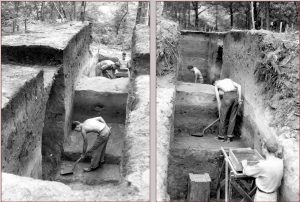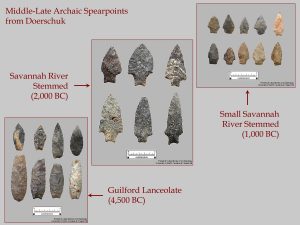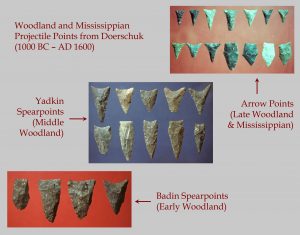Doerschuk (Archaic)

The Doerschuk site (31MG22) was named after and discovered by Herbert Doerschuk in 1928, and is located on the east bank of the Yadkin River just below Falls Dam. Along with the Hardaway site, the Doerschuk site was instrumental in allowing Joffre Coe to create a chronological sequence of Archaic projectile point types based on intact stratigraphy. In 1948, Coe and Paul Strieff excavated a small test pit at the site. In 1949, Coe came back with James Wood and two high school boys in order to expand the first test pit he had started. Coe’s excavations recovered an enormous amount of material, including more than 6,800 artifacts spanning a period of more than 8,000 years. Unfortunately, the Doerschuk site was subject to the same damaging forces as Hardaway – photographs taken over the years show the great amount of damage done to the site by illicit pot hunting.

Research and Importance
The Doerschuk site was a stratified site that contained ceramic-bearing zones, with Late Archaic Savannah River and Middle Archaic Guildford materials beneath the ceramic zones. Beneath the Guilford material were zones with Morrow Mountain and Stanly-type spear points.

These excavations suggested that Stanly spear points were a good cultural marker for the beginning of the Middle Archaic period in the North Carolina Piedmont. Stanly spear points look like a broad triangular blade with a small square stem notched at the base; some people have said they look like a Christmas tree.
Why do we care about all these different point types? Initially, archaeologists thought that the differences between the Stanly spear points and the Morrow Mountain, Guilford, and Halifax types represented the sequential arrival of different groups of people with different cultural traditions, so each of them had their own type of point that they liked to make. Stone points are a little more complicated than this simplistic explanation, however, and the same point can change shape as it is made, used, and refurbished. Now, archaeologists see that there appear to be more similarities between the points, suggesting cultural continuity rather than discontinuity. This explanation is supported by the fact that, even at sites like Doerschuk with deeply buried strata, the various Middle Archaic point types are found mixed together throughout most of the deposits, suggesting that they were all being used at the same time.
Point type sequences from Doerschuk.
Overall, the tool assemblages associated with Middle Archaic period sites are seen as simple but ubiquitous. At Doerschuk, we see evidence for the use of the atlatl, or spear thrower. Fragments of the stone weight attached to the handles of atlatls were found along with Stanly points. Crude chipped-stone axes are found at other sites, such as Gaston, where they were recovered with Guilford spear points. Other than the atlatl weights, spear points, and axes, Middle Archaic sites in the Piedmont have few formal tools. The scraping and cutting tasks that would have been performed every day were done with “expedient” tools that have little evidence for sharpening or shaping. People would have quickly knocked off large flakes from stone cores; these large flakes were sharp enough to do the job that people needed to be done, rather than spending time making more specific tools. After being used, the flakes were then discarded.
More broadly, Middle Archaic sites tend to be numerous and also seem to be temporary camps. Sites from this time period are found across the Piedmont landscape without any clear preference for particular types of environments. The tool assemblages are thought to indicate that people subsisted primarily through foraging. Site locations and numbers suggest small, kin-related groups that moved as a unit from place to place for food and other resources. Some archaeologists think that the settlement and subsistence pattern during the Middle Archaic was related to a change in climatic conditions that occurred at the end of the Early Archaic period. This climate change is called the Altithermal, or Climatic Optimum, beginning around 6,000 B.C. and lasting until about 2,000 B.C. This was a time when the weather became drier and warmer, resulting in a patchy, less predictable environment. For the people living in the Piedmont, these environmental changes would have required them to have flexible subsistence strategies. The foraging that we think people were doing at this time would have been perfectly suited to such an environment, as it would have allowed people to move around easily among a variety of resources as they became available.
Sources:
Coe, Joffre L.
1964 • The Formative Cultures of the Carolina Piedmont. Transactions of the American Philosophical Society, n.s., 54, pt. 5, Philadelphia.
Ward, Trawick H., and R.P. Stephen Davis, Jr.
1999 • Time Before History: The Archaeology of North Carolina. University of North Carolina Press, Chapel Hill.



